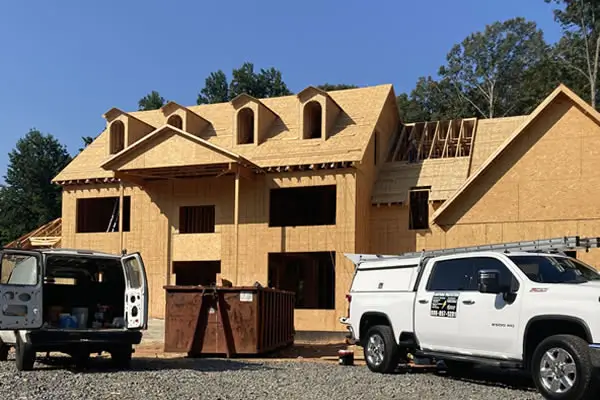Call 24/7 at 571-839-4793 for a Quote
What are Lightning Rods?
Lightning rods are metal rods or conductors mounted on top of buildings, structures, or other elevated areas to protect them from lightning strikes. They work by providing a low-resistance path for the electrical current from a lightning strike to travel safely to the ground. Here’s a bit more detail on how they function:
- Attraction of Lightning: When a storm cloud builds up a significant electrical charge, it induces an opposite charge in the ground below. The lightning rod, usually made of conductive materials like copper or aluminum, can attract these electrical charges due to its pointed shape.
- Conduction: When lightning strikes, the rod intercepts the lightning bolt, providing a preferred path for the electric current to travel. The rod is connected to a conductive wire or system that runs down to the ground, effectively channeling the electric charge away from the structure.
- Dissipation: The electrical current from the lightning is safely dissipated into the ground, minimizing the risk of fire, structural damage, or electrical surges in the building.
The primary purpose of lightning rods is to protect buildings and other structures from the destructive force of lightning by safely directing the electrical energy away from the structure and into the earth.
Questions? Fill out the form below to contact us 24/7. We will get back to you within 24 hours.


What is a lightning rod?
A lightning rod is a metal rod or conductor mounted on top of a building or structure to protect it from lightning strikes. It provides a safe path for the electrical current from a lightning strike to travel to the ground.
How do lightning rods work?
Lightning rods work by attracting lightning strikes and providing a low-resistance path for the electrical current to travel safely to the ground. The rod is connected to a conductive wire or system that directs the current away from the structure and into the earth.
Do lightning rods prevent lightning strikes?
No, lightning rods do not prevent lightning strikes. Instead, they protect structures by safely directing the electrical energy from a strike away from the building and into the ground.
Where should lightning rods be installed?
Lightning rods should be installed at the highest points of a structure, such as the roof or any tall protrusions. They are often placed on chimneys, towers, or other elevated areas to maximize their effectiveness.
What materials are lightning rods made of?
Lightning rods are typically made of conductive materials such as copper, aluminum, or steel. These materials are chosen for their ability to conduct electricity efficiently.
Do all buildings need lightning rods?
Not all buildings need lightning rods, but they are recommended for structures that are particularly tall, isolated, or located in areas prone to frequent lightning storms. Buildings with sensitive electronic equipment or flammable materials may also benefit from lightning protection systems.
How often should lightning rods be inspected?
Lightning rods and their associated grounding systems should be inspected regularly, at least once a year, to ensure they are in good condition and functioning properly. After any significant lightning event, an inspection is also advisable.
Can lightning rods protect electronics inside a building?
While lightning rods primarily protect the structure from fire and damage, they can also help protect electronic equipment by reducing the risk of electrical surges. However, additional surge protection devices may be necessary for sensitive electronics.
Are lightning rods effective during all types of storms?
Lightning rods are effective during thunderstorms that produce lightning. They do not provide protection from other weather-related hazards such as wind, hail, or flooding.
How much does it cost to install a lightning rod system?
The cost of installing a lightning rod system can vary depending on the size and complexity of the structure, the materials used, and the labor involved. On average, the cost can range from a few hundred to several thousand dollars.
Can lightning rods be installed on existing buildings?
Yes, lightning rods can be retrofitted onto existing buildings. A professional installer can assess the structure and recommend the best locations for installation to ensure optimal protection.
Do lightning rods attract lightning?
Lightning rods do not attract lightning in the sense of increasing the likelihood of a strike. Instead, they provide a safe path for the current to follow if a strike occurs near the protected structure.
NOVA Lightning Protection are Lightning Protection Specialists Providing Rods installs for Commercial & Residential Lightning Protection throughout Northern Virginia, Annapolis, Maryland, Washington, DC, West Virginia, North Carolina, South Carolina, Delaware, Pennsylvania and beyond

